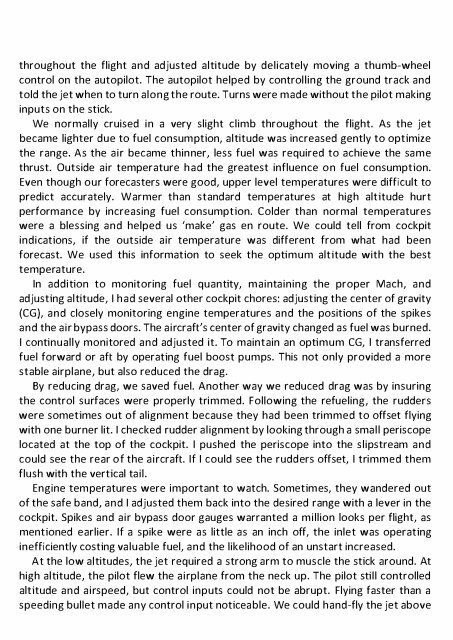Create successful ePaper yourself
Turn your PDF publications into a flip-book with our unique Google optimized e-Paper software.
throughout the flight and adjusted altitude by delicately moving a thumb-wheel<br />
control on the autopilot. The autopilot helped by controlling the ground track and<br />
told the jet when to turn along the route. Turns were made without the pilot making<br />
inputs on the stick.<br />
We normally cruised in a very slight climb throughout the flight. As the jet<br />
became lighter due to fuel consumption, altitude was increased gently to optimize<br />
the range. As the air became thinner, less fuel was required to achieve the same<br />
thrust. Outside air temperature had the greatest influence on fuel consumption.<br />
Even though our forecasters were good, upper level temperatures were difficult to<br />
predict accurately. Warmer than standard temperatures at high altitude hurt<br />
performance by increasing fuel consumption. Colder than normal temperatures<br />
were a blessing and helped us (make' gas en route. We could tell from cockpit<br />
indications, if the outside air temperature was different from what had been<br />
forecast. We used this information to seek the optimum altitude with the best<br />
temperature.<br />
In addition to monitoring fuel quantity, maintaining the proper Mach, and<br />
adjusting altitude, I had several other cockpit chores: adjusting the center of gravity<br />
(CG), and closely monitoring engine temperatures and the positions of the spikes<br />
and the air bypass doors. The aircraft's center of gravity changed as fuel was burned.<br />
I continually monitored and adjusted it. To maintain an optimum CG, I transferred<br />
fuel forward or aft by operating fuel boost pumps. This not only provided a more<br />
stable airplane, but also reduced the drag.<br />
By reducing drag, we saved fuel. Another way we reduced drag was by insuring<br />
the control surfaces were properly trimmed. Following the refueling, the rudders<br />
were sometimes out of alignment because they had been trimmed to offset flying<br />
with one burner lit. I checked rudder alignment by looking through a small periscope<br />
located at the top of the cockpit. I pushed the periscope into the slipstream and<br />
could see the rear of the aircraft. If I could see the rudders offset, I trimmed them<br />
flush with the vertical tail.<br />
Engine temperatures were important to watch. Sometimes, they wandered out<br />
of the safe band, and I adjusted them back into the desired range with a lever in the<br />
cockpit. Spikes and air bypass door gauges warranted a million looks per flight, as<br />
mentioned earlier. If a spike were as little as an inch off, the inlet was operating<br />
inefficiently costing valuable fuel, and the likelihood of an unstart increased.<br />
At the low altitudes, the jet required a strong arm to muscle the stick around. At<br />
high altitude, the pilot flew the airplane from the neck up. The pilot still controlled<br />
altitude and airspeed, but control inputs could not be abrupt. Flying faster than a<br />
speeding bullet made any control input noticeable. We could hand-fly the jet above


